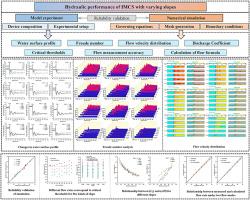变坡度u形沟道一体化闸门水力及流量测量性能研究
IF 2.7
3区 工程技术
Q2 ENGINEERING, MECHANICAL
引用次数: 0
摘要
采用实验和数值方法对u型沟道综合测控闸(IMCS)进行了系统研究,考察了沟道底部坡度对测量精度和流量的影响。考虑水闸开度e = 4-18 cm,对应入水流速Q = 10-50 L/s。通道底部的支撑系统允许灵活调整坡度,设置范围为1/5000-1/100。分析了水面剖面、弗劳德数、流速分布、闸流和堰流临界状态、计算方程和流量测量精度。结果表明:在不同工况下,上游水深随流量的增大而增大,随闸门开度和底部坡度的增大而减小;反之,下游水面剖面随流量和闸门开度的变化呈相反趋势。值得注意的是,随着底部坡度的增加,水力跳跃的长度显著增加。推导的自由出水量测量公式具有较高的相关系数和精度,相对误差始终保持在5%以下,满足灌渠水量测量的精度标准。此外,所提出的IMCS系统能够适应底部坡度的变化,有效地将测控功能结合起来,避免了过度用水,提高了灌溉效率。这些发现为灌溉系统中水量测量基础设施的发展和应用提供了有价值的见解。本文章由计算机程序翻译,如有差异,请以英文原文为准。

Hydraulic and flow measurement performance of integrated sluice gates in U-shaped channels with varying slopes
Integrated measurement and control sluices (IMCS) are systematically investigated in U-shaped channels through both experimental and numerical methods to examine the effects of channel bottom slopes on measurement accuracy and flow capacity. The sluice gate opening degree considered is e = 4–18 cm, corresponding to incoming flow rate Q = 10–50 L/s. The support system at the bottom of the channel allows for flexible adjustment of the slope, with a setting range of 1/5000-1/100. The water surface profile, Froude number, flow velocity distribution, critical state of sluice gate flow and weir flow, calculation equations, and flow measurement accuracy are analyzed. Results show that, under varying operating conditions, the upstream water depth increases directly with the flow rate, while decreasing as the gate opening and bottom slope increase. Conversely, the downstream water surface profile exhibits an inverse trend in response to changes in flow rate and gate opening. Notably, the length of the hydraulic jump significantly increases with steeper bottom slopes. The derived measurement formula for free outflow demonstrates a high correlation coefficient and accuracy, with the relative error consistently remaining below 5 %, thus meeting the required accuracy standards for water measurement in irrigation channels. Furthermore, the proposed IMCS system is capable of adapting to changes in bottom slope, effectively combining measurement and control functions, avoiding excessive water usage, and enhancing irrigation efficiency. These findings provide valuable insights for the development and application of water measurement infrastructure in irrigation systems.
求助全文
通过发布文献求助,成功后即可免费获取论文全文。
去求助
来源期刊

Flow Measurement and Instrumentation
工程技术-工程:机械
CiteScore
4.30
自引率
13.60%
发文量
123
审稿时长
6 months
期刊介绍:
Flow Measurement and Instrumentation is dedicated to disseminating the latest research results on all aspects of flow measurement, in both closed conduits and open channels. The design of flow measurement systems involves a wide variety of multidisciplinary activities including modelling the flow sensor, the fluid flow and the sensor/fluid interactions through the use of computation techniques; the development of advanced transducer systems and their associated signal processing and the laboratory and field assessment of the overall system under ideal and disturbed conditions.
FMI is the essential forum for critical information exchange, and contributions are particularly encouraged in the following areas of interest:
Modelling: the application of mathematical and computational modelling to the interaction of fluid dynamics with flowmeters, including flowmeter behaviour, improved flowmeter design and installation problems. Application of CAD/CAE techniques to flowmeter modelling are eligible.
Design and development: the detailed design of the flowmeter head and/or signal processing aspects of novel flowmeters. Emphasis is given to papers identifying new sensor configurations, multisensor flow measurement systems, non-intrusive flow metering techniques and the application of microelectronic techniques in smart or intelligent systems.
Calibration techniques: including descriptions of new or existing calibration facilities and techniques, calibration data from different flowmeter types, and calibration intercomparison data from different laboratories.
Installation effect data: dealing with the effects of non-ideal flow conditions on flowmeters. Papers combining a theoretical understanding of flowmeter behaviour with experimental work are particularly welcome.
 求助内容:
求助内容: 应助结果提醒方式:
应助结果提醒方式:


